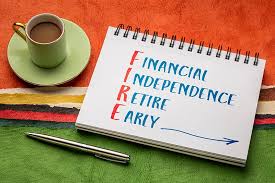Financial independence and early retirement (FIRE) have become an increasingly popular goal for many people, especially those seeking a life free from the constraints of a traditional 9-to-5 job. Achieving FIRE means having enough wealth and passive income to support your lifestyle without the need for regular employment. While this might sound like a distant dream for many, with the right strategies, it is possible to achieve financial freedom at an earlier age than most people imagine.
In this article, we will explore the steps involved in achieving financial independence and early retirement, including understanding the FIRE movement, creating a sustainable savings plan, investing wisely, and making intentional lifestyle changes.
What is Financial Independence and Early Retirement (FIRE)?
Before diving into the specifics of how to achieve FIRE, it’s important to define what it means. The FIRE movement is all about reaching a point where your assets generate enough income (typically through investments) to cover your living expenses, allowing you to retire early or have the financial freedom to pursue other passions and goals. Financial independence (FI) is the point at which you no longer need to rely on earned income to maintain your standard of living, and early retirement (ER) is the ability to stop working long before the traditional retirement age.
The key concepts of FIRE include:
- Financial Independence (FI): Accumulating enough wealth and passive income (from investments, side businesses, etc.) to cover your living expenses indefinitely.
- Early Retirement (ER): Choosing to retire earlier than the traditional retirement age, often in your 30s or 40s, by cutting out unnecessary expenses and building a sustainable income stream.
The path to FIRE may look different for everyone, but the ultimate goal is to free yourself from the obligation of working for money, allowing you to live life on your own terms.
How to Achieve Financial Independence and Early Retirement
1. Start by Setting Clear Financial Goals
The first step in achieving FIRE is defining your specific financial goals. This includes determining:
- Your Target Retirement Age: How old do you want to be when you retire? For some, early retirement may mean leaving work in their 30s, while for others, it might be in their 40s or 50s.
- Your Desired Lifestyle: What kind of lifestyle do you want to lead in retirement? Do you want to travel, start a business, or focus on hobbies? Estimating your desired living expenses in retirement will help you set a target for how much money you need to accumulate.
- How Much Passive Income You Need: Once you have an idea of your desired lifestyle, you can calculate how much passive income you need to generate to cover your expenses. This number will help you determine how much you need to save and invest.
Setting clear and specific goals will help you stay motivated, track your progress, and make informed decisions about how to allocate your resources.
2. Live Below Your Means and Save Aggressively
One of the key principles of the FIRE movement is living below your means. The more money you can save, the faster you can achieve financial independence. A large portion of your savings will need to go toward investments that will generate passive income.
Here are some tips for saving aggressively:
- Cut Unnecessary Expenses: Review your monthly expenses and identify areas where you can cut back. This could involve downsizing your living situation, reducing discretionary spending, or eliminating debt. Consider whether you’re spending money on things that align with your long-term goals and make adjustments accordingly.
- Create a Budget and Stick to It: A detailed budget helps you track your income and expenses, making it easier to find areas for savings. Categorize your spending and allocate a specific percentage to savings. Aim to save at least 50-70% of your income, which is common among those pursuing FIRE.
- Embrace Minimalism: Simplify your lifestyle by focusing on the essentials and reducing the number of material possessions you accumulate. This not only lowers your expenses but also helps you prioritize what really matters to you.
- Increase Your Income: While cutting expenses is important, increasing your income can also help you accelerate your journey to financial independence. Look for ways to increase your earning potential, such as negotiating your salary, switching to a higher-paying job, or starting a side hustle.
3. Build Multiple Streams of Passive Income
To achieve financial independence, it’s essential to develop multiple streams of passive income—money that is generated without requiring active work. The most common sources of passive income include:
- Investments in Stocks and Bonds: Investing in the stock market, particularly low-cost index funds, can provide you with returns that outpace inflation over time. Stocks and bonds offer dividends and interest payments, which can supplement your income.
- Real Estate Investments: Investing in rental properties or real estate crowdfunding platforms can generate regular rental income. Real estate can be a great way to build wealth, as property values tend to increase over time, and rental income can provide a steady cash flow.
- Dividend-Paying Stocks: Some stocks pay regular dividends, which can be reinvested or used as a source of passive income. Dividend investing is a popular strategy among those pursuing FIRE.
- Peer-to-Peer Lending: Platforms like LendingClub and Prosper allow you to lend money to individuals or small businesses in exchange for interest payments. This is another way to generate passive income.
- Online Businesses: Creating an online business, such as a blog, e-commerce store, or online course, can provide an ongoing income stream. Once established, these businesses can generate income with minimal ongoing effort.
Building multiple passive income streams will ensure that you have a diverse range of income sources, reducing risk and increasing financial security.
4. Invest Wisely and Take Advantage of Tax-Advantaged Accounts
Investing is key to building wealth, and understanding how to invest your money wisely will help you grow your assets faster. Consider the following investment strategies:
- Stock Market: Investing in low-cost index funds and exchange-traded funds (ETFs) is one of the most efficient ways to build wealth over time. These funds offer broad diversification and are less risky than individual stocks. Historically, the stock market has provided an average annual return of around 7% after inflation.
- Tax-Advantaged Retirement Accounts: Take full advantage of retirement accounts such as 401(k)s, IRAs, and Roth IRAs. These accounts offer tax benefits that can help your money grow more quickly. Contributions to a 401(k) or traditional IRA are tax-deductible, reducing your taxable income in the short term, while Roth IRAs provide tax-free growth on investments.
- Real Estate: Investing in real estate can be a powerful way to build wealth, as properties often appreciate over time. Additionally, rental income can provide a steady stream of passive income. Real estate investment trusts (REITs) are another option if you prefer a more hands-off approach.
- Dollar-Cost Averaging (DCA): Rather than trying to time the market, invest a fixed amount of money at regular intervals, regardless of market conditions. This strategy, known as dollar-cost averaging, helps reduce the impact of market volatility and lowers the risk of investing large sums of money during market peaks.
5. Understand the 4% Rule
One of the most popular guidelines for determining how much money you need to retire is the 4% rule. This rule suggests that you can safely withdraw 4% of your total savings each year without running out of money. In other words, if you accumulate 25 times your annual expenses in investments, you should be able to retire without depleting your funds.
For example, if your annual expenses are $40,000, you would need $1,000,000 in investments to retire comfortably ($40,000 x 25). The 4% rule provides a general estimate of how much you need to accumulate in order to achieve financial independence, but it’s important to account for factors like inflation, unexpected expenses, and changes in lifestyle.
6. Consider Your Retirement Needs and Adjust Your Plan Over Time
As you work toward financial independence, it’s important to reassess your plan periodically. Consider your:
- Lifestyle Changes: Your needs and expenses will change over time. As you get closer to retirement, you may find that your spending habits shift, or that you want to retire earlier than originally planned.
- Investment Performance: Regularly review your investment portfolio to ensure that it is aligned with your goals and risk tolerance. Adjust your asset allocation based on market conditions and your financial situation.
- Unexpected Events: Be prepared for unforeseen events, such as medical emergencies or economic downturns, that may impact your financial plans. Having an emergency fund and diversifying your income streams can help you weather these challenges.
Conclusion
Achieving financial independence and early retirement is a challenging yet rewarding goal that requires dedication, discipline, and smart financial strategies. By setting clear goals, saving aggressively, investing wisely, and creating multiple streams of passive income, you can achieve the freedom to retire earlier and live life on your terms. The FIRE movement is not just about quitting your job—it’s about designing a life that allows you to focus on what truly matters, whether that’s pursuing hobbies, traveling, or spending more time with loved ones.
While the path to financial independence may take time, it’s possible to make steady progress toward your goals by staying focused, adjusting your plan as needed, and remaining committed to your vision of a financially free future.

